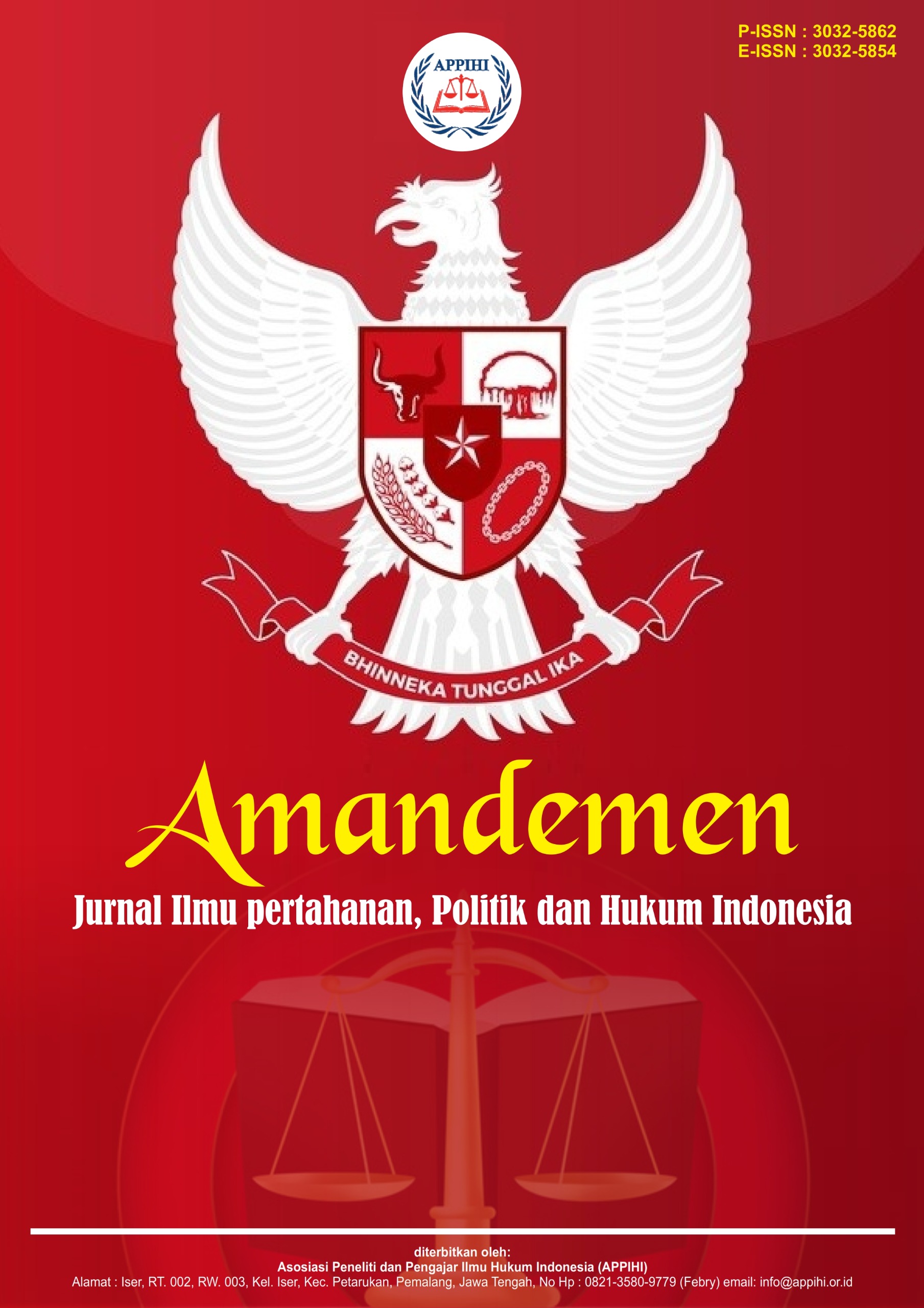Penerapan Prinsip Tanggung Jawab dan Sanksi Pidana dalam Hukum Kesehatan terhadap Peredaran Kosmetik Ilegal
DOI:
https://doi.org/10.62383/amandemen.v2i3.1018Keywords:
illegal cosmetics, element of fault, principle of liabilityAbstract
This research aims to conduct a juridical analysis of cases of circulation of illegal cosmetic products. The method used is normative-dogmatic juridical research, which focuses on relevant legal doctrines and principles. The approach used is a conceptual approach and a statutory approach, with primary legal sources including the Health Law, BPOM Regulations, the Criminal Code (KUHP), and the Criminal Procedure Code (KUHAP). Secondary legal sources include journals, books, and other references that support the analysis. The results show that the distribution of illegal cosmetic products that do not meet safety and quality standards, as in the case of the defendant Megawati binti Rahmat alias Mega in verdict number 39/Pid.Sus/2020/PN Slr, is a serious violation of health law and consumer protection in Indonesia. Based on the principle of liability based on the element of fault, the defendant can be held legally responsible because it is proven that she distributed cosmetics without a distribution permit containing hazardous substances such as mercury. The Panel of Judges considered that the defendant's actions fulfilled the elements of unlawful acts in accordance with Article 1365 of the Civil Code and Article 196 of Law of the Republic of Indonesia Number 36 of 2009 concerning Health. The implications of this research emphasize the importance of strict law enforcement and the application of the principle of responsibility to protect public health from dangerous cosmetic products.
Downloads
References
Akay, B. T. (2019). Sahnya Suatu Perjanjian Yang Diatur Dalam Pasal 1320 Dan Pasal 1338 Kitab Undang-Undang Hukum Perdata. Lex Privatum, 7(3).
Ali, Z. (2021). Metode penelitian hukum. Sinar Grafika.
Ariyanto, B., Purwadi, H., & Latifah, E. (2021). Tanggung Jawab Mutlak Penjual Akibat Produk Cacat Tersembunyi Dalam Transaksi Jual Beli Daring. Refleksi Hukum: Jurnal Ilmu Hukum, 6(1), 107–126.
Asirah, A., Sofyan, A. M., & Muin, A. M. (2023). Upaya Penegakan Hukum Peredaran Kosmetik Ilegal Melalui E-Commerce Oleh Ppns Bbpom Makassar. UNES Law Review, 5(3), 1013–1033.
Azizah, I., Zamroni, M., & Pramono, A. (2024). Perlindungan Hukum Konsumen Terhadap Kosmetik Ilegal yang Diiklankan Influencer di Media Sosial. Innovative: Journal Of Social Science Research, 4(3), 6896–6905.
Bilal, A. I., Tilahun, Z., Osman, E. D., Mulugeta, A., Shekabdulahi, M., & Berhe, D. F. (2016). Cosmetics Use-Related Adverse Events and Determinants Among Jigjiga Town Residents, Eastern Ethiopia. Dermatology and Therapy, 7(1), 143–153. https://doi.org/10.1007/s13555-016-0157-y
Borowska, S., & Brzóska, M. M. (2015). Metals in Cosmetics: Implications for Human Health. Journal of Applied Toxicology, 35(6), 551–572. https://doi.org/10.1002/jat.3129
Dinake, P., Motswetla, O., Kereeditse, T. T., & Kelebemang, R. (2023). Assessment of Level of Heavy Metals in Cosmetics. Toxicology Research and Application, 7, 239784732311566. https://doi.org/10.1177/23978473231156620
Erwinsyahbana, T. (2018). Kewenangan dan Tanggung Jawab Notaris Pengganti setelah Pelaksanaan Tugas dan Jabatan Berakhir. Lentera Hukum, 5, 323.
Feizi, R., Jaafarzadeh, N., Akbari, H., & Jorfi, S. (2019). Evaluation of Lead and Cadmium Concentrations in Lipstick and Eye Pencil Cosmetics. Environmental Health Engineering and Management, 6(4), 277–282. https://doi.org/10.15171/ehem.2019.31
Filan, C. M., Fernandes, J. F., Siswanto, C. A., & Indradewi, A. A. (2024). Efektivitas Undang-Undang Perlindungan Konsumen Dalam Menanggulangi Peredaran Komestik Ilegal Di Surabaya. Iuris Studia: Jurnal Kajian Hukum, 5(2). https://doi.org/10.55357/is.v5i2.600
Halla, N., Fernandes, I. P., Heleno, S. A., Costa, P., Boucherit-Otmani, Z., Boucherit, K., Rodrigues, A. E., Ferreira, I. C., & Barreiro, M. F. (2018). Cosmetics Preservation: A Review on Present Strategies. Molecules, 23(7), 1571. https://doi.org/10.3390/molecules23071571
Jairoun, A. A., Al‐Hemyari, S. S., Shahwan, M., & Zyoud, S. H. (2020). An Investigation Into Incidences of Microbial Contamination in Cosmeceuticals in the UAE: Imbalances Between Preservation and Microbial Contamination. Cosmetics, 7(4), 92. https://doi.org/10.3390/cosmetics7040092
Juanda, J., & Untari, D. T. (2022). Legal Protection for Consumers Against Illegal Cosmetic Products. International Journal of Health Sciences, 4344–4348. https://doi.org/10.53730/ijhs.v6ns4.9444
Kaličanin, B., & Velimirović, D. (2015). A Study of the Possible Harmful Effects of Cosmetic Beauty Products on Human Health. Biological Trace Element Research, 170(2), 476–484. https://doi.org/10.1007/s12011-015-0477-2
Kristiyanti, C. T. S. (2022). Hukum perlindungan konsumen. Sinar Grafika.
Massie, E. N. E. (2021). Tanggung jawab perusahaan ekspedisi muatan kapal laut atas kerusakan dan kehilangan barang dengan menggunakan transportasi laut. Lex Privatum, 9(3).
Mugiono, M., & Indradewi, A. A. (2025). Quo Vadis Regulasi dan Penegakan Hukum terhadap Peredaran Roti yang Mengandung Zat Berbahaya. Jatiswara, 40(1), 1–11. https://doi.org/10.29303/jtsw.v40i1.1202.
Mugiono, M., Steven, A., Indradewi, A. A., & Siswanto, C. A. (2024). Efektivitas Penanganan Produk Yang Beredar Oleh BPOM Surabaya: Dampak Bagi Konsumen Dan Kesehatan Masyarakat. UNES LAW REVIEW, 6(4). https://doi.org/10.31933/unesrev.v6i4.2187
Mustafa, D. W., Sagoni, S., & Dewi, B. M. (2023). Penegakan Hukum Pidana Terhadap Pelaku Usaha Kosmetik Ilegal. Legal Journal of Law, 2(2), 46–55.
Novasari, K. D., & Fithria, N. (2024). Perlindungan Konsumen Dari Produk Kosmetik Ilegal Menurut Hukum Islam: Studi Pada BPOM Aceh, Indonesia. Al-Mudharabah: Jurnal Ekonomi Dan Keuangan Syariah, 5(1), 164–178.
Pusnawan, I. M. L. (2020). Sanksi Hukum Terhadap Endorser yang Mempromosikan Produk Kosmetik Ilegal. Journal IJCCS, 8(7).
Rahmadania, S. R. (2023). BPOM Temukan 51.791 Kosmetik Ilegal di 731 Klinik Kecantikan, Terbanyak di Wilayah Ini. https://health.detik.com/berita-detikhealth/d-7278666/bpom-temukan-51-791-kosmetik-ilegal-di-731-klinik-kecantikan-terbanyak-di-wilayah-ini
Sembiring, S., & Pratama, B. P. (2022). Perlindungan Terhadap Konsumen Kosmetik Ilegal Yang Mengandung Zat Berbahaya. Jurnal Ilmiah Ekotrans & Erudisi, 2(1), 83–87.
Umboh, A. (2018). Tanggung Jawab Pelaku Usaha Dalam Pemenuhan Hak Konsumen Menurut Hukum Positif Indonesia. Lex Privatum, 6(6).
Winata, M. G. (2022). Perlindungan Hukum Bagi Korban Pengguna Produk Kosmetik Ilegal Berbahaya. Sapientia Et Virtus, 7(1), 34–43.
Wnuk, W., Michalska, K., Krupa, A., & Pawlak, K. (2022). Benzophenone-3, a Chemical UV-filter in Cosmetics: Is It Really Safe for Children and Pregnant Women? Advances in Dermatology and Allergology, 39(1), 26–33. https://doi.org/10.5114/ada.2022.113617
Downloads
Published
How to Cite
Issue
Section
License
Copyright (c) 2025 Amandemen: Jurnal Ilmu pertahanan, Politik dan Hukum Indonesia

This work is licensed under a Creative Commons Attribution-ShareAlike 4.0 International License.





